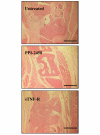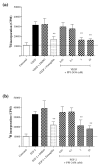Methionine aminopeptidase-2 blockade reduces chronic collagen-induced arthritis: potential role for angiogenesis inhibition
- PMID: 18072970
- PMCID: PMC2246249
- DOI: 10.1186/ar2340
Methionine aminopeptidase-2 blockade reduces chronic collagen-induced arthritis: potential role for angiogenesis inhibition
Abstract
The enzyme methionine aminopeptidase-2 (MetAP-2) is thought to play an important function in human endothelial cell proliferation, and as such provides a valuable target in both inflammation and cancer. Rheumatoid arthritis (RA) is a chronic inflammatory disease associated with increased synovial vascularity, and hence is a potential therapeutic target for angiogenesis inhibitors. We examined the use of PPI-2458, a selective non-reversible inhibitor of MetAP-2, in disease models of RA, namely acute and chronic collagen-induced arthritis (CIA) in mice. Whilst acute CIA is a monophasic disease, CIA induced with murine collagen type II manifests as a chronic relapsing arthritis and mimics more closely the disease course of RA. Our study showed PPI-2458 was able to reduce clinical signs of arthritis in both acute and chronic CIA models. This reduction in arthritis was paralleled by decreased joint inflammation and destruction. Detailed mechanism of action studies demonstrated that PPI-2458 inhibited human endothelial cell proliferation and angiogenesis in vitro, without affecting production of inflammatory cytokines. Furthermore, we also investigated release of inflammatory cytokines and chemokines from human RA synovial cell cultures, and observed no effect of PPI-2458 on spontaneous expression of cytokines and chemokines, or indeed on the angiogenic molecule vascular endothelial growth factor (VEGF). These results highlight MetAP-2 as a good candidate for therapeutic intervention in RA.
Figures








References
Publication types
MeSH terms
Substances
LinkOut - more resources
Full Text Sources

